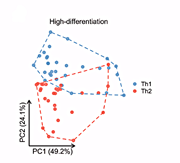Analysis of Th1/Th2 cytokine profile and clinical characteristics of patients with head and neck squamous cell carcinoma
DOI:
https://doi.org/10.17305/bb.2024.10783Keywords:
Cytokine, Th1/Th2 cytokine, Head and neck squamous cell carcinoma, IL-1β, InterferonAbstract
Immune system biomarkers in cancer pathogenesis offer new therapeutic avenues, as seen in cytokine (CK) profiles of laryngeal and hypopharyngeal tumors. A retrospective analysis was conducted on 58 patients with laryngeal and hypopharyngeal tumors and 27 patients with benign vocal cord lesions to explore the role of serum CKs in these diseases’ characteristics and immunotherapy. The differences in the levels of 12 cytokines were measured. Additionally, the study examined the correlation between T helper cells (Th)1/Th2 cytokine levels and the clinical characteristics and immunotherapy efficacy of laryngeal and hypopharyngeal cancers. The results show that the balance of Th1/Th2 is biased towards Th2 in patients with laryngeal and hypopharyngeal tumors. Among these, interleukin (IL)-6 (P = 0.021) was highly expressed in laryngeal tumors, and the expression levels of IL-1β (P = 0.008), IL-6 (P = 0.005), and IL-8 (P = 0.05) were higher in patients with poorly differentiated laryngeal tumors. The level of IL-4 (P = 0.0048) was significantly correlated with tumor location. The expression levels of IL-2 (P = 0.010), IL-4 (P = 0.028), IL-10 (P = 0.011), IL-12p70 (P = 0.034), IL-17 (P = 0.024), tumor necrosis factor (TNF)-α (P = 0.003), and interferon (IFN)-γ (P = 0.007) were related to lymph node metastasis. The level of IFN-γ (P = 0.016) was correlated with the efficacy of neoadjuvant therapy, while the level of IFN-α (P = 0.013) was significantly correlated with programmed death ligand 1 (PD-L1) expression. The Principal Component Analysis (PCA) results showed that patients with tumors, poor differentiation, and lymph node metastasis had higher levels of Th1 and Th2 cytokine separation. In conclusion, the shift in the balance of Th1 and Th2 cytokine expression indicates higher tumor invasiveness, and IFN has potential as a circulating molecular marker for immunotherapy of head and neck squamous cell carcinoma.
Citations
Downloads

Downloads
Published
Issue
Section
Categories
License
Copyright (c) 2024 Wang Rong, Yin Gaofei, Guo Wei, Li Nuan, Zhang Yang, Chen Xiaohong, Huang Zhigang

This work is licensed under a Creative Commons Attribution 4.0 International License.









